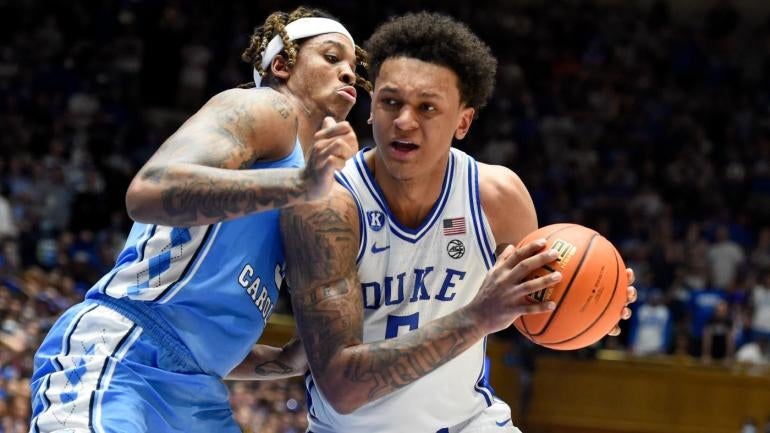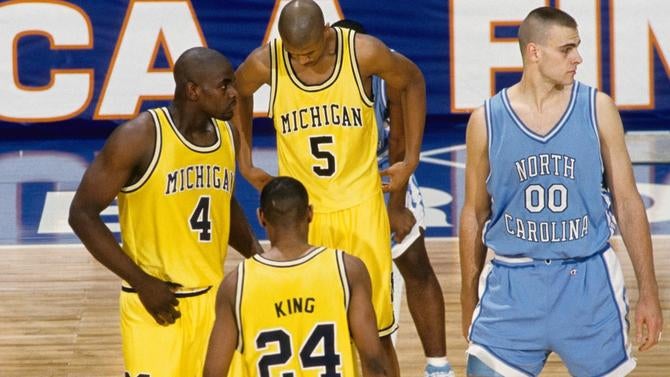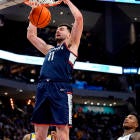
The 2022 NCAA Tournament has been a wild ride filled with everything we love about the annual college basketball frenzy. There have been upsets, underdogs, dramatic finishes and heroic performances. In the end, though, the Final Four of Duke, North Carolina, Kansas and Villanova is a group of the sport's royalty.
In fact, it may be the most blue-blood heavy Final Four ever. North Carolina owns six national titles, Duke has five and Kansas and Villanova each have three. The combined 17 national titles of the group fall short of the combined 23 titles that have been won by the 1975 Final Four of UCLA, Kentucky, Louisville and Syracuse.
But any Final Four with UCLA in it will rank highly on the blue-blood scale if combined national titles are the determining metric, as the Bruins have 11 titles on their own. This season's collection of programs registers strongly even without UCLA or Kentucky (the Wildcats have eight), who are first and second on the NCAA's all-time national titles list.
Is this officially the most blue-blood heavy Final Four of all-time? It depends on how you define "blue blood" in college basketball and how you compare different eras with the benefit of hindsight. But it has a case. Here's a ranking of the Final Fours in the running for most blue-blood heavy of all-time as we get ready to see four of the sport's biggest brands battle it out for the national title.
1. 2022: North Carolina, Duke, Kansas, Villanova
Sure, having UCLA or Kentucky in the mix here could increase the group's collective total of national titles. But each of these four have cut down the nets at some point since 2008. In fact, no one outside this group won the national title between 2015 and 2018. Additionally, between 2008 and 2018, each of these four teams won at least one national championship, and collectively the group combined for seven titles over that span. The only program in this Final Four whose blue blood status is debatable is Villanova. While two of the Wildcats' three national titles have come under Jay Wright in recent years (2016 and 2018), they were no pushovers before his arrival. Villanova made three Final Four appearances before Wright's tenure and won it all under Rollie Massimino in 1985. As a No. 8 seed, that team is still the worst-seeded team to ever win it all. Wright has certainly taken the program to new heights in his 21 seasons, but Villanova is more than a one-coach wonder.
2. 1975: UCLA*, Kentucky, Louisville, Syracuse
(*won NCAA Tournament)
John Wooden won his 10th and final national championship against a stacked Final Four field before retiring after beating Louisville in the title game. Now, we look back and see a combined 23 national championships between these teams. Back then, Syracuse and Louisville had yet to win one. The Cardinals were in just their fourth season under Denny Crum, who was a former player and assistant under Wooden. Jim Boeheim was still an assistant for the Orange. Kentucky was in its third season under Joe B. Hall. Given that Louisville and Syracuse were just beginning their ascensions to true national prominence, this one comes in a close second behind the 2022 Final Four in terms of blue-blood prowess. How wild is it that Boeheim, who just finished his 46th season as Syracuse's coach, can say that he coached against Wooden? The 1975 Final Four was a bridge between eras of the game, and the 2022 Final Four could be remembered in the same way as Duke tries to send Mike Krzyzewski out with a national title.

3. 1993: North Carolina*, Michigan, Kentucky, Kansas
This was the Final Four decided by a classic title game between North Carolina and Michigan. But the semifinal game between UNC and Kansas was an epic matchup. Former UNC assistant Roy Williams was in his fifth season with the Jayhawks and coaching against his mentor, Dean Smith, at UNC. Smith got the best of his pupil and went on to win his second and final national championship. It was the program's last until 2009 under Williams. Kentucky was in its fourth season under Rick Pitino in this Final Four. Though Michigan's case for blue-blood status is relatively weak, the Wolverines were just four years removed from winning it all in 1989, and there is no question the other three were and are blue-blood programs.
4. 1991: Duke*, Kansas, North Carolina, UNLV
UNLV's status as one of college basketball's top programs has not stood the test of time. In fact, 1991 was the program's last Final Four appearance as the Jerry Tarkanian era neared its end. At the time, the Runnin' Rebels were the defending national champions and making their third Final Four appearance in a five-year span. UNLV's track record under Tarkanian combined with the clear blue-blood status of Duke, Kansas and North Carolina give the 1991 Final Four a good case for most blue-blood heavy. If Villanova falls off the sport's map after Jay Wright's coaching tenure like UNLV has in the past three decades, then perhaps one day this Final Four will rank just as high on the blue-blood meter.
5. 2008: Kansas*, Memphis, UCLA, North Carolina
This is the only time in NCAA Tournament history that all four No. 1 seeds reached the Final Four, and it brought Kansas' only national title under Bill Self. Though not a blue blood, Memphis is a strong college basketball brand, and the Tigers were coached by John Calipari at the time. UCLA has obviously fallen off since Wooden's tenure, but this marked the Bruins' third straight Final Four appearance under Ben Howland. Of course, each of these teams are indeed blue, which can't hurt its case in the blue-blood debate.

















